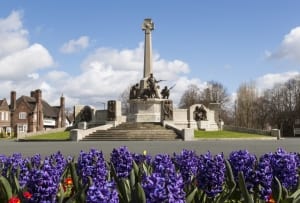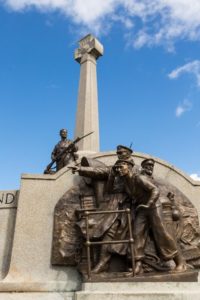The Centenary of the Unveiling of Port Sunlight’s War Memorial

This year marks the centenary of the official unveiling of the Port Sunlight War Memorial at the intersection of The Diamond and The Causeway. This eloquent expression of communal pride and sorrow was erected to honour the memory of four hundred and eighty one men from Lever Brothers who fell in the First World War and the four thousand employees of Lever Brothers and its associated companies in the U.K. and around the World who fought in the war. At a re-dedication service in November, 1947 the names of one hundred and eighteen Port Sunlight men killed in the Second World War were inscribed, together with Port Sunlight civilians killed as a result of enemy action.
The magnificent Grade I listed monument was designed by a famous sculptor of the time, Sir William Goscombe John R.A. He was a prolific Welsh sculptor known for his statues of eminent Victorians and war memorials which includes his Memorial to King Edward VII at Pier Head, Liverpool and his Memorial to The King’s Liverpool Regiment in St. John’s Gardens, Liverpool. He also created the effigies of Lord and Lady Leverhulme in the loggia at Christ Church, Port Sunlight. He was a leading figure of the British New Sculpture Movement of the late nineteenth and early twentieth century which espoused a vigorous naturalistic representation of the human body, something very much in evidence in the figures on the Port Sunlight memorial, Goscombe John was approached by Lord Leverhulme regarding the designing of a memorial as early as 1916. Lord Leverhulme feared that leading sculptors like Goscombe John would have far more commissions for war memorials by the end of the war than they would have time to execute. In May 1917 a general meeting at the Lyceum unanimously approved of the design for the Memorial submitted by the sculptor. Money for the Memorial was raised through subscription, but it seems unlikely that a monument on this scale and costing around £10,000 could have been fully completed without financial help from the company as well.
The stonework for the Memorial was carried out by Messrs William Kirkpatrick Limited of Manchester and the bronze metal work by Mr A. B. Burton, bronze founder, of Thames Ditton, Surrey. The monument created was a grand one, standing 38 feet from ground level. Around the large granite Village Cross at the centre of Memorial are eleven life-size bronze figures representing the theme of the defence of the home. A party of soldiers are shown defending women and children from attack by an invading enemy. The parapet surrounding the platform has four bronze groups representing the Sea, Land, Air Forces and the Red Cross. At the sides of the four flights of steps leading to the platform are eight bronze panels featuring children offering wreaths and garlands as symbols of gratitude.

The official unveiling of the Memorial took place on Saturday, 3rd December 1921 before an attendance of seven thousand people. The unveiling ceremony began with the assembly of several processions. Earlier special services had been held in Christ Church and the neighbouring churches – St. Andrew’s, Bebington; St. Mark’s, New Ferry and St. John’s, New Ferry and at the end of these, the various congregations processed to the site of the Memorial. They were joined there by some one thousand five hundred school children who had come together for their own service in the Auditorium. While these various parties were assembling, the Port Sunlight Brass Band played Handel’s Largo and this plaintive melody was described as evoking an air of throbbing sadness on the cold bright winter morning.
Following the hymn ‘Recessional’, Lord Leverhulme delivered a solemn oration to the large crowd in which he recalled the great contribution made by Port Sunlight and Lever Brothers to the war effort, but now with the war won, he also spoke about restoring peace and good will, love and fellowship, trade and commerce with all peoples. After this Lord Leverhulme joined two ex-servicemen beneath the Cross. One of these, Ex-Sergeant Thomas George Eames, with the assistance of Lord Leverhulme and Private Robert Cruickshank V.C. pulled away the coverings from the central group of bronze figures. At the same time twelve other ex-service men assisted by unveiling the other groups and various panels of the Memorial. When this part of the ceremony was completed, five ex-service buglers sounded the ‘Last Post’ and a two minutes’ silence was observed. After Lord Leverhulme and six Port Sunlight children had placed wreaths at the base of the Cross, a more private ritual followed where those who were bereaved began to move forward to the Memorial to lay their own wreaths. Representatives of the branches, and of the works and offices at Port Sunlight, as well as all of the village’s societies and institutions formed part of this procession too.
Ex-Sergeant Eames who assisted in the ceremony had begun working for Lever Brothers at their factory in Port Sunlight when he was a boy in 1901. In September 1914 he had been one of the seven hundred volunteers who travelled by train to Chester en masse to join the 13th Battalion of the Cheshire Regiment. After being wounded in France, he was transferred to the 15th Battalion (the Bantams) of the Cheshire Regiment and while fighting with this unit, he lost the sight of both eyes at the Battle of the Somme in 1916, one of the nearly two thousand British soldiers who became blind as a result of the war. When the time came to unveil Port Sunlight’s new memorial, Lord Leverhulme suggested that the honour of this task should be given to a veteran. Thomas Eames was chosen after a free vote by his comrades and this evidenced the admiration felt by those who knew him for the fortitude with which he bore his great loss and manner in which he set out to make the best of what remained of his life. He sang with a rich baritone voice, and this, along with his cheery character, made him a popular presence at gatherings of Port Sunlight’s ex-service men afterwards. Later the same day the Port Sunlight Branch of the Royal British Legion was at a meeting of ex-service men in Hulme Hall when the United Comrades Federation of Lever Brothers Ltd. (UCF) was established. By the 1950s this branch had become the largest in the country with over four thousand members.
James Hayes
PSVT Collections Officer
Image Credits: Port Sunlight Village Trust Photographer Paul Thompson
If you would like to learn more, James Hayes will be delivering a lecture to commemorate the centenary of unveiling of the Port Sunlight War Memorial. For more details including how to book please follow the link: https://www.portsunlightvillage.com/whats-on/

